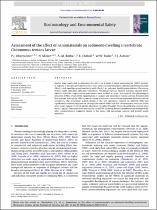 ResearchSpace
ResearchSpace
Assessment of the effect of nanomaterials on sediment-dwelling invertebrate Chironomustentans larvae
JavaScript is disabled for your browser. Some features of this site may not work without it.
- ResearchSpace
- →
- Research Publications/Outputs
- →
- Journal Articles
- →
- View Item
| dc.contributor.author |
Oberholster, Paul J

|
|
| dc.contributor.author |
Musee, N

|
|
| dc.contributor.author |
Botha, A-M

|
|
| dc.contributor.author |
Botha, PK

|
|
| dc.contributor.author |
Focke, WW

|
|
| dc.contributor.author |
Ashton, PJ

|
|
| dc.date.accessioned | 2011-05-27T13:49:12Z | |
| dc.date.available | 2011-05-27T13:49:12Z | |
| dc.date.issued | 2011-03 | |
| dc.identifier.citation | Oberholster, P.J., Musee, N., Botha, A-M. et al. 2011. Assessment of the effect of nanomaterials on sediment-dwelling invertebrate Chironomustentans larvae. Ecotoxicology and Environmental Safety, vol. 74(3), pp 416-423 | en_US |
| dc.identifier.issn | 0147-6513 | |
| dc.identifier.uri | http://www.sciencedirect.com/science/article/pii/S0147651310003957 | |
| dc.identifier.uri | http://hdl.handle.net/10204/5028 | |
| dc.description | Copyright: 2011 Elsevier. This is the post print version of the work. The definitive version is published in Ecotoxicology and Environmental Safety, vol. 74(3), pp 416-423 | en_US |
| dc.description.abstract | Studies were conducted to determine the effects of a panel of seven nanomaterials (NMs), namely: a-alumina, -alumina, precipitated silica; silica fume, calcined silica fume, colloidal antimony pentoxide (Sb2O5), and superfine amorphous ferric oxide (Fe2O3), on sediment dwelling invertebrates Chironomus tentans under controlled laboratory conditions. Percentage survival, enzyme activities, growth development, and DNA fragmentation parameters were studied as acute, biochemical, and physiological toxicities of NMs, respectively. Quantitation of catalase and peroxidase enzyme activity demonstrated that toxicant stress of the NMs increased enzyme activity in a concentration dependent fashion across all treatments. The percentage growth length of the test specimens exposed to different NMs was significantly reduced compared to the negative control while only five concentrations were not in the toxic range, namely; Fe2O3 (5 µg/kg); silica fume (5 µg/kg, 50 µg/kg); Sb2O5 (5 µg/kg) and calcined silica fume (5 µg/kg). Genotoxic stress assessed by use of DNA laddering showed complementary findings to the other ecotoxicological endpoints tested in this study—the percentage survival and growth length inhibition. | en_US |
| dc.language.iso | en | en_US |
| dc.publisher | Elsevier | en_US |
| dc.relation.ispartofseries | Workflow;6309 | |
| dc.subject | Nanomaterials | en_US |
| dc.subject | Chironomus tentans | en_US |
| dc.subject | Bioassays | en_US |
| dc.subject | Ecotoxicology | en_US |
| dc.subject | DNA damage | en_US |
| dc.title | Assessment of the effect of nanomaterials on sediment-dwelling invertebrate Chironomustentans larvae | en_US |
| dc.type | Article | en_US |
| dc.identifier.apacitation | Oberholster, P. J., Musee, N., Botha, A., Botha, P., Focke, W., & Ashton, P. (2011). Assessment of the effect of nanomaterials on sediment-dwelling invertebrate Chironomustentans larvae. http://hdl.handle.net/10204/5028 | en_ZA |
| dc.identifier.chicagocitation | Oberholster, Paul J, N Musee, A-M Botha, PK Botha, WW Focke, and PJ Ashton "Assessment of the effect of nanomaterials on sediment-dwelling invertebrate Chironomustentans larvae." (2011) http://hdl.handle.net/10204/5028 | en_ZA |
| dc.identifier.vancouvercitation | Oberholster PJ, Musee N, Botha A, Botha P, Focke W, Ashton P. Assessment of the effect of nanomaterials on sediment-dwelling invertebrate Chironomustentans larvae. 2011; http://hdl.handle.net/10204/5028. | en_ZA |
| dc.identifier.ris | TY - Article AU - Oberholster, Paul J AU - Musee, N AU - Botha, A-M AU - Botha, PK AU - Focke, WW AU - Ashton, PJ AB - Studies were conducted to determine the effects of a panel of seven nanomaterials (NMs), namely: a-alumina, -alumina, precipitated silica; silica fume, calcined silica fume, colloidal antimony pentoxide (Sb2O5), and superfine amorphous ferric oxide (Fe2O3), on sediment dwelling invertebrates Chironomus tentans under controlled laboratory conditions. Percentage survival, enzyme activities, growth development, and DNA fragmentation parameters were studied as acute, biochemical, and physiological toxicities of NMs, respectively. Quantitation of catalase and peroxidase enzyme activity demonstrated that toxicant stress of the NMs increased enzyme activity in a concentration dependent fashion across all treatments. The percentage growth length of the test specimens exposed to different NMs was significantly reduced compared to the negative control while only five concentrations were not in the toxic range, namely; Fe2O3 (5 µg/kg); silica fume (5 µg/kg, 50 µg/kg); Sb2O5 (5 µg/kg) and calcined silica fume (5 µg/kg). Genotoxic stress assessed by use of DNA laddering showed complementary findings to the other ecotoxicological endpoints tested in this study—the percentage survival and growth length inhibition. DA - 2011-03 DB - ResearchSpace DP - CSIR KW - Nanomaterials KW - Chironomus tentans KW - Bioassays KW - Ecotoxicology KW - DNA damage LK - https://researchspace.csir.co.za PY - 2011 SM - 0147-6513 T1 - Assessment of the effect of nanomaterials on sediment-dwelling invertebrate Chironomustentans larvae TI - Assessment of the effect of nanomaterials on sediment-dwelling invertebrate Chironomustentans larvae UR - http://hdl.handle.net/10204/5028 ER - | en_ZA |





